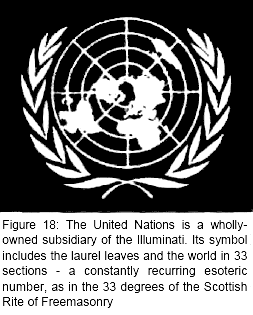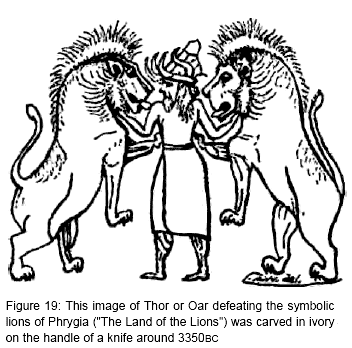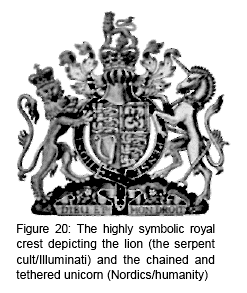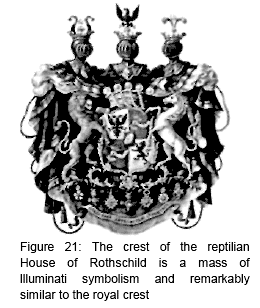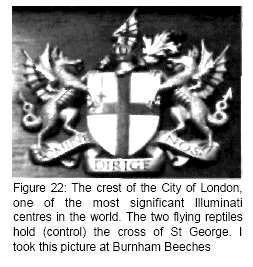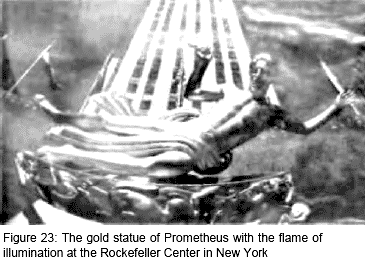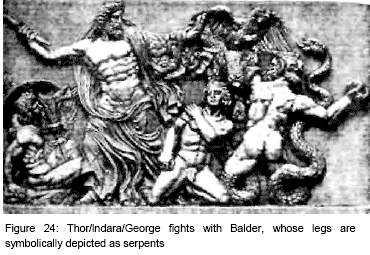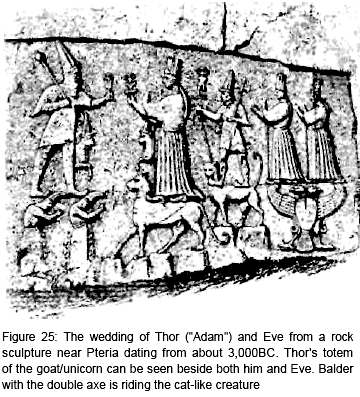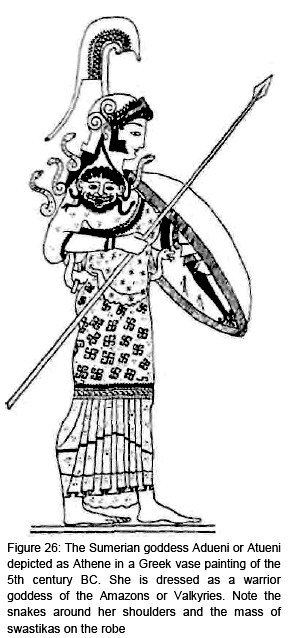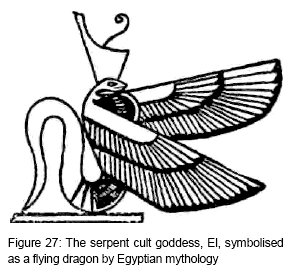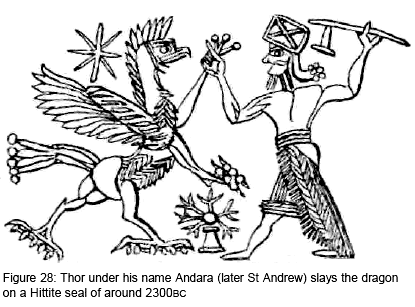|
The Illuminati appear on the surface to be a male-dominated operation.
But, in fact, the high priestess is as important in their rituals as the high priest and at the heart of Illuminati symbolism is the worship of the goddess -the serpent goddess. The New Age movement wants a return of the "goddess" because it is equated with female energy and releasing women from suppression. On that level, so do I.
But it is vital for New Agers and others to understand that this is not the "goddess" symbolism the Illuminati and their placemen talk about. They just want you to think it is. The serpent goddess is known under countless names around the world, including Diana, Artemis, Athene, Semiramis, Barati, Britannia, Hecate, Rhea, Persephone ("First Serpent") and so on.
These same names have also been used to symbolize esoteric concepts like the phases of the Moon and female energy, but at its foundation this goddess worship of the Illuminati would seem to relate to the DNA transmitted through the female and possibly originating in the constellation of Orion. I have heard this DNA source symbolized in various cultures as the Dragon Queens, the Orion Queen or Queens, and the "Snake Mother".
From what I am told by insiders and serious researchers, the full-blown reptilian society has its own version of queen bees, which produce the eggs from which the bloodlines and their offshoots, originate. Artemis, a key Illuminati goddess, is depicted with eggs all over her chest and she is associated with bees. One of the prime symbols of the Merovingian bloodline, so connected to Artemis/Diana worship, is the bee and the hive.
You also find this symbolism in Freemasonry. The reptilians and greys have been described over and over by abductees and experiences as having a kind of swarm or hive mentality, very much like bees, and they have worked to make the human race a mirror of that.
Researcher Frans Kamp also came across this theme of the Orion Queen:
I have been told many times that the DNA carried by the female in the reptilian bloodlines is the most important to them and the symbolism of the "goddess" and the "serpent" have been linked since ancient times. Sir Laurence Gardner is a spokesman for the Imperial Royal Dragon Court and Order that represents the interests of the "Dragon bloodlines" seeded by the DNA of the "Dragon Queens".
He says that this symbolism and the theme of the Dragon Queens goes back to the "founding mother" of the Anunnaki he calls Tiamat, the Sea-dragon in Mesopotamian accounts. These queens, he suggests, were commonly represented as mermaids (amphibious/Sirius?), and were often called Ladies of the Lake (see In the Realm of the Ring Lords).
Throughout the lands settled by the former Atlantean-Lemurian peoples you find the worship of the serpent goddess and her serpent son, who is often symbolized as a bull. James Churchward reveals from ancient tablets and artwork that Lemurians worshipped the goddess called "Queen Moo", and that Lemuria/Mu was called the "Motherland". Around the Mediterranean the priest-kings were known as the "Children of the Serpent Goddess".2
In this same region, temples and Mystery schools were created in her name, most notably the Temple of Artemis/Diana at Ephesus in Turkey, one of the seven wonders of the ancient world. Turkey (formerly Asia Minor), Greece, and the islands of Samothrace, Cyprus, and Crete were among the main centers of the goddess cult. Samothrace, "the Sacred Isle", seems to have been the headquarters for this in the Mediterranean/Aegean region. Here the rites of the "Sisterhood of Daughters" of the Goddess Hecate were performed.3
She was depicted with snake feet and snakes for hair.4 Dogs, the sacred animal to Hecate, were sacrificed to her in these rituals during the dark phase of the Moon. This emphasis on the dog in Hecate myth could connect her symbolically to the "dog star" Sirius, a base for the reptilians. In Colchis, that ancient Egyptian settlement at the foot of the Caucasus Mountains, there was a cemetery sacred to Hecate. Jason of the Argonaut legends was said to have offered a sacrifice to Hecate at Colchis.5 (Colches-ter is the oldest recorded town in England and its first Roman capital).
The Illuminati Satanic network continues to perform sacrifice rituals to Hecate and this goddess was massively part of the symbolism surrounding the ritual murder of Princess Diana, as explained in The Biggest Secret. Indeed, Diana could well have been a sacrifice to Hecate, the triple-headed goddess with the symbolism of Sirius, Sirius B, and Sirius C. The name, Hecate, literally means "One Hundred".
Both Sirius B
and C take 50 years to orbit Sirius A and the symbolism of one
hundred, the duel orbit of "the twins", was often used as code for
the Sirius system, according to Robert Temple in
The Sirius Mystery. It is also important to note that, as Temple
points out, the ancient Egyptian word and hieroglyph for goddess
also means serpent, and their hieroglyph for Sirius also means
tooth. Thus the stories of the "serpent's tooth" can be read as the
"Goddess Sirius". The Egyptian word for tooth also means dog and,
more specifically, dog-god and one hundred.7
Greece was another serpent goddess culture. They called her Athene and at Delphi, the Oracles (interdimensional channelers) would speak the words of the serpent goddess, known there as Delphinia.9 The Oracle would go into a trance state while staring into the eyes of a snake. She would also use cannabis and chew laurel leaves, the sacred herb of the goddess or "pythoness".
The laurel leaves are used by the Illuminati in the symbol of Freemasonry and the logo of the United Nations, in which they frame an Earth broken into an esoterically significant 33 segments (Figure 18).
Pythagoras, the famous Greek
hero and mathematician, grew up in the mysteries of the serpent
goddess cult and his very name means "I am the Python" or "I am the
Serpent".
That's according to its official website, anyway. The Dragon Court was re-launched in the 15th century as the Hungarian Court of the Dragon and was strongly connected with "Dracula".
He loves titles, old Larry. He has
written a number of books, including
Bloodline Of The Holy Grail
(1996), in which he claims that
the Merovingians and their offshoots, like the British House of
Stuart, were seeded by Jesus and Mary
Magdalene. This is not the case, as we'll see, although there could
be some symbolic truths in the theme of a "Jesus" and "Mary"
bloodline. Gardner, in my view, knows far more than he is telling,
although, if you read between the lines, he's already telling quite
a lot. He has been given great prominence by the Australia-based
Nexus magazine, which claims to expose how the world is manipulated.
The Greeks called it Ambrosia ("supernatural red wine" of the goddess Hera), while in India it was Soma (the food of the gods) and in Persia, haoma. They believed the menstrual blood was sacred and the life essence that could bring immortality. Sir Laurence Gardner calls the Anunnaki bloodlines the "dragon bloodlines", but claims that this derives only from the use of crocodile fat in the royal ceremonies of ancient Egypt. Right, Larry, and I can hang by my willy from a hot air balloon.
He dismisses any idea that these bloodlines are reptilian shape-shifters, although he acknowledges that such claims were made in ancient times. He said in a Nexus magazine article that he found it hard to imagine that anyone (i.e. me) could still believe such stories in these more enlightened times. Mmmm. The records of Sumer, Gardner says, reveal that the Anunnaki had a "creation chamber" to produce these "royal" bloodlines and he says that the senior line of descent was determined by the "Mitochondrial DNA of the Dragon Queens".
Gardner talks of the "Blood Royal" or
Sang Graal in the "womb of the Dragon Queen". Other texts in France
called this bloodline, "Le Serpent Rouge" - the red serpent or the
serpent blood.10 The female or "goddess" DNA is most definitely the
key here.
A female elf was called an elbe, he says, and this is the inspiration for Albi, the main city of the Cathars or Aligensians, in their stronghold in the Languedoc region of southern France.
"Gens", as we saw earlier, relates to tribe and is used to this day as a code for the bloodlines. The Cathars appeared to be close to the Knights Templar, who also had a major presence in that same area around the mysterious mountain-top village of Rennes-le-Chateau. Could this mountain have been an inner-earth entrance to a reptilian base? It certainly seems to be an interdimensional doorway. I have been all around there and the whole area has a very strange vibe.
The horrific slaughter of the Cathars by armies of Pope Innocent III and the Roman Church ended with the siege of their mountain-top fortress at Montsegur in 1244. Gardner's contention is that the Roman Church destroyed the "dragon" succession when it removed the Merovingians from power in the 8th century and began to appoint its own monarchs, including Charlemagne, in what later became France. Gardner says that the church also suppressed the female and worship of the "goddess" (Dragon Queen) with its male-dominated religion.11 I beg to differ. We shall see that while the Roman Church and Christianity in general is an outwardly male religion, it is secretly a continuation of pagan goddess worship.
Also, the reptilian bloodlines constantly fight with each other for
power, and the
Roman Church, Charlemagne, and
the Merovingians were
different expressions of the same reptilian bloodlines battling with
each other to be top dog - as usual.
The emphasis by the serpent cult on the female is also confirmed. The Edda text was found in Iceland in the 12th century and was believed by scholars to be of Icelandic and Scandinavian origin.
Waddell reveals in his book, British Edda (Christian Book Club, California, 1929) that it is actually written in Old Briton, a language closely linked to Old English, Anglo-Saxon, and Eastern Gothic. And Gothic came from the Sumerian, which came from Atlantis/Lemuria. The Edda is not of Icelandic origin, but British.12 It was taken to Iceland, it appears, by settlers from Scotland, Orkney, the Hebrides, and North Britain. Among them were the Culdees, who had their headquarters at St Andrews in Scotland, an area with strong Illuminati connections to this day.13
The "Culdees" came from "Chaldees", a people who followed the Sumer Empire in Mesopotamia and worshipped the mother-son cult in which they claimed that God's son had died to save them. This was long before Christianity. And, of course, these northern lands of Europe were the realms of the Nordics who went south to the Near and Middle East thousands of years ago before returning as the "Sumerians", the "Phoenicians", and the "Egyptians".
Scholars have misrepresented the Edda, not least because an Icelander called Snorri Sturlason (1179-1241) included his translations of this text in his own work. This led to the erroneous idea that he had compiled it. But he merely used sections from it and mistranslated them to a large extent. He mistook the titles and personal names of the same person to be names of different people and the whole meaning was lost.14
Waddell again
used his knowledge of ancient languages to retranslate the Edda and
he says it tells the story of events in ancient Troy and Cappadocia,
both now in Turkey, and the Danube Valley in Europe. These events
and their heroes and villains became foundations for myths and
legends throughout the former Sumer Empire and later entered the
texts that became the Bible.
L.A. Waddell first began to see the connections between apparently unconnected people and events during his early days in India while studying Hindu history and mythology. He noticed that Eindri, the name used in the Edda text for the European and Norse "god" called Thor, was remarkably close to the Hindu god, Indra. The Indian Vedas, which were inspired by the Lemurian and Sumerian legends and accounts, describe Indra as tall, fair, invincible, and armed with a bolt.
This is how Eindri or Thor is described in the Edda and Waddell concluded from considerable research that the European god, Thor, and the Hindu god, Indra, were the same person, and that this guy was also the first "Aryan" king of Sumer. The Vedas connect Indra to the Greek god Zeus, also known as Jupiter. Some Sanskrit scholars regarded Indra as the same as Jupiter and suggested that he was a heroic human king who had led the early Aryans or "Nordics" to victory against the "serpent cult".
Waddell produces a stream of evidence to show that the Hindu god, Indra, and the European, Thor, after whom we get Thursday or "Thors-day", are the same person or deity. He also says that the legend of Thor is the origin of the legends of King Arthur. Thor is known in the Edda as Her-Thor, which became Ar-Thur. Both Her and Ar come from the same root meaning...Aryan.15 The mist began to clear even further when Waddell observed that the name of the first Aryan king of the Sumerians in ancient Mesopotamia had the name of Indara, In Dur, In-Tur, or King Tur.16
This, Waddell says, later became Thor of northern Europe and Prometheus of the Greeks. Indara was the traditional founder of civilisation and was deified by the Sumerians.17 He was said to have defeated the demons and slayed the serpent-dragon and the "giants", and his Sumerian titles are identical in the Sumerian and the Edda, where he appears as Eindri or Thor.
Like Thor, Indara was also portrayed with a hammer by the Sumerians. The fairy story of Jack and the Beanstalk or Jack the Giant Slayer comes from the tales of Indara/Thor. A title for Thor in the Edda is Sig or Ygg, which, in Sumerian and Cappadocian inscriptions, is spelt Zagg or Zakh. This is the origin of the modern name, Jack.18
Waddell writes of Indara:
Waddell presents more than 100 seals and sculptures from Sumer and
the Hittites that portray scenes described in the British Edda. He
says he could have
In Egypt, Waddell says, Indara (Thor) was known by the title of Asari, which became Osiris, the leading deity in the Egyptian worship of the Sun. Osiris was often depicted as a blue-eyed Aryan, just as Indara was. King Indara, Dur or Tur of Sumer, Indra of India, Thor or Eindri or Andvara (Andrew) of the Edda, Osiris of Egypt, and the original version of King Arthur, are all the same person, Waddell contends. So, he says, is Dar-Danos, the first king of Troy in Homer's Iliad. Thor was known as Dan and from this same root you get Danube and Danmark, the Danish spelling for Denmark.
The name relates to the Danaans, who originated in Atlantis. The British Israelite movement claims that the "lost tribes of Israel", especially the Tribe of Dan, moved out of the Middle East and settled in the British Isles and Europe. This, they claim, led to the names Danube and Danmark and therefore makes the British, and their genetic kin, God's "chosen people".
They have, however, completely lost the plot, I would suggest, not least because they are obsessed with the idea that the Bible is accurate. It is not! The Edda says that Thor (Dan) and his Aryans went from Europe in the first place to settle in Turkey and Mesopotamia and found the civilization of Sumer. That is precisely what happened, as I indicated earlier. It also says that the Aryans of the Danube Valley were already well in advance of the rest of the world before they went down to Mesopotamia.20
The Danube Valley is very significant to the bloodlines. The Danube is the second longest river in Europe and runs from Germany through Romania ("Dracula" country) and into the Black Sea. The Edda says that Thor fought and defeated the serpent worshippers of Phrygia (in Turkey), a word that comes from the Sumerian name, Firig or Pirig, and it means literally "Land of the Lions".21
Thor is depicted on ancient carvings symbolically fighting and taming "lions" in this battle with the Phrygians (Figure 19) and so we have the symbolic Hebrew story of Dan-iel taming the lion. Thor was also "Midas", the king who turned everything into gold with the "Midas touch".22 His victory over the Phrygians was commemorated in those ancient lands in a monument known as the Tomb of Midas, although it is not actually a tomb.
On it are nine enormous crosses
of St George (another name for Thor-Indara) and dates to about
1000BC.23
The red Sun-Cross is also the symbol of the Knights Templar secret society which has played a major role in the story of the bloodlines over hundreds of years and, of course, it is the logo of the Red Cross organization, which, as I outline in The Biggest Secret, is an Illuminati creation to allow them to manipulate within countries during wars and other events behind the cover of humanitarian aid. The vast majority of genuine Red Cross workers are not aware of this. The Red Cross was also flown on the ships of Christopher Columbus, an Illuminati frontman, whom historians still insist discovered the Americas.
The Red Cross or Sun-Cross was originally written as a T and this became the "T-square" of Freemasonry, or the Tau cross. The splayed cross known as the Maltese Cross, so beloved of British royalty, was also found depicted in caves within this same Sumer Empire. This is today the symbol of the Knights of Malta (formerly the Knights Hospitaller of St John of Jerusalem and the Knights of Rhodes). The Knights of Malta are another elite and extremely sinister secret society and they have been around for the same period as the Knights Templar.
The ruling bloodlines and their secret society web, the Illuminati,
are obsessed with symbolism and ritual and, as I have indicated,
they use the same symbols and ceremonies today that their ancestors
did who ruled the Sumer Empire, Atlantis, and Lemuria.
Same old story, and again we see the theme of the Nordics or "Aryans" in conflict with the serpent people. The Edda says there were three main leaders of this serpent cult. They were the serpent goddess known as El; her consort, the male entity called Wodan (Votan was the Atlantean fire god); and their son, Baldr or Balder. This was the serpent "trinity" of mother-father-son.
El was also known as Eldi or "Fiery El", the "Hound", and, highly significantly, as "Mary".24 From this cult and "Fiery El" came the term Hell, "burning in Hell" and "fires of Hell." El or Hel was the Norse queen of the underworld and her followers became known as "kinsman of Hel".25 In Medieval times, this was symbolized as the "Harlequin", the lover of the maiden Columbine-the-Dove. Columba, Columbine, and the symbol of the dove are all other names and symbols for El, the serpent or dragon queen of the Edda.
The more I research, the more the world that exists under our feet becomes increasingly significant.
The underground "Hell" is supposed to be the place of judgment and eternal punishment where the "Devil" and evil spirits dwell beneath the Earth. The longer we go on, the more you will see how relevant this is to the races and bloodlines that manipulate this world. El is the Hebrew name for "God" and she was also known as Heidi and Ida.
The Elohim, the gods of the Old Testament, were the race of El, a dragon queen. The Greeks knew El as Artemis, the cruel mother-goddess who demanded human sacrifice. Artemis (also known as Diana) was the major deity of the Merovingians. Artemis was symbolized with bees, as is the Merovingian bloodline. It is the same with other versions of the goddess like Demeter, the "pure mother bee", and a symbol of Aphrodite was a golden honeycomb.
Her priestess was given the name Melissa, or "Queen Bee". The word honeymoon comes from this. It spanned a lunar month, normally in May, which was named after the Virgin Maya, another version of El. The honeymoon would include the menstrual period of the bride and the combination of menstrual blood and honey was once thought to be the elixir of life. El is also the inspiration for the children's stories of Mother Hubbard or "Mother Hubur", as she was to the Babylonians.
Mother Hubbard was distressed because she couldn't find a bone for her dog (a domesticated wolf)-Mother Hubur, also Tiawath, was described as the,
The other members of the serpent trinity in the Edda, consort Wodan and son Balder, were major "gods" of the reptilian-controlled Nazis. The Nazis were the creation of the Teutonic Knights network (Illuminati) in Germany which has always been associated with the highly significant reptilian bloodline known as the Habsburgs. The Teutonic Knights operated in the same "Holy Land" in the same period as the Knights Templar and the Knights of Malta and they work to the same reptilian agenda. Wodan and Balder were national deities of the Teutons.
The legendary
founder of the Maya culture in Mexico was also called Votan or
Wotan.
The legend is rampant in Greek mythology, which was inherited from Sumerian mythology, and the Amazons were known as the Valkeries in northern Europe, the warrior-maidens from Valhalla. The Greek historian, Herodotus, said the Amazons were enemies of the Greeks and he claimed that they lived in the steppelands of the Ukraine and southern Russia, once known as Scythia and Sauromatia (sauro = lizard and mater = mother). Other areas claimed for their homeland are Lycia, Phrygia, and Cappadocia, all of which are named in the Edda accounts, and Taurus, Lemnos and Lebos, hence lesbian.
The foothills of the Caucasus Mountains in southern Russia was a major location for the Amazons and this would seem to have been a major centre for the interbreeding of the Nordics with the reptilian bloodlines. Libya is another place of Amazon legend and in those days Libya referred to the whole of North Africa, except for Egypt.
The Amazon River and region in South America was named after these women when a Portuguese explorer in the 16th century found fighting women there. Legends and accounts depict the Amazons as a nomadic people dominated by women and they appeared to be extremely ritualistic. Strabo, the Greek geographer, said they would only "mate" during a special two-month period, just like animals do. Sex was strictly for the production of children.26
Among the gods and goddesses they
worshipped was once again Artemis, a later name for "El" of the Edda
texts, and Hecate, the dark Moon goddess and "goddess of the
Infernal Arts". It appears that Amazon means "Moon Woman" and this
again fits with the Edda texts about the serpent cult.
Historical accounts say that the Amazons in Sauromatia bred with Scythian warriors. The Scythians were a Nordic-Aryan people who moved into northern Europe from the Near and Middle East through the Caucasus Mountains and Sauromatia, and they included the bloodlines that became the Sicambrian Franks and... the Merovingians. Once again we have the theme of Nordic-reptilian interbreeding. The fusion of the Amazon and Scythian language became known as Sauromatian.
The Scythians worshipped the same goddess as the Amazons. They castrated themselves and wore women's clothing as part of their ritual to the goddess known by the Greeks as Artemis. One location for the Scythians was called Partia or "Virginland" in deference to their goddess and when the Illuminati moved in on America they used the same symbolism in naming Virginia. The idea that it was named after Elizabeth 1st, the "virgin queen", is ludicrous. First of all, she was no more a virgin than Madonna. The Scythians were governed by priestess-queens, who tended to be older women.
In 1954 five kurgans or "queen-graves" were found in southern Russia at Pasyryk. These priest-queens performed sacrifices and caught the blood in "sacred cauldrons", and went with the men into battle and cast spells for victory. This again fits with the Edda texts and is almost certainly the origin of the witches in "Shakespeare's" Macbeth. In the Celtic legends the cauldron is associated with the underground world and has been symbolically connected to the womb of the "death-goddess". Using this theme, children of the bloodlines come "out of the cauldron" - the womb of the women who carry "royal blood", the reptilian DNA.
The
Moon-sickle used by the Scythians, the mythical weapon that
castrated the gods, became known as the scythe and was associated
with the "grim reaper". Yet again the grim reaper refers to a
goddess, Rhea, who was clothed in a
garment of blood and devoured all of her offspring, the gods. She
became the Celtic goddess Rhiannon. Eire, the Celtic name for
Ireland, comes from the name of the goddess Erinn, a form of Hera or
Rhea.
They looked pretty human, but had skin like a reptile, he says. Interestingly, the Edda reveals that the forbears of the Nordic peoples under the leadership of Thor-Indara were also members of the "The Seafaring Wolf Tribe". An Irish tribe in Ossory were said to become wolf people while attending the Yuletide feast or ritual, and they devoured the flesh of cattle as wolves before regaining their human shape. This could all be symbolic or it could be connected to the phenomena of the "werewolf" which, according to some former Satanists, do exist.
The legends of the "Troll" or "Trulli" demons also appear to be associated with the Amazons or Valkeries. This is the root of the word, Trull, which means loose woman and the Troll could have been a Pagan "Hag" or Earth-priestess. Norse myth says that the trolls waited under bridges waiting to eat those who crossed without making an offering. The Valkeries were said to guard the bridge to heaven or the "Bifrost".
Angels of Death were said to attend a ritual called the trolla-thing. Woden's day Wodan was the consort of the dragon queen, El, according to the Edda, and he is a major figure in ancient myths. One of the older names for Wodan (also Wotan or Woden) is Bodo or Bauta. This corresponds with the Sumerian name of Budu, Butu, or Budun, which means "The Serpent Footed".28
In Waddell's translation of the Edda, Wodan was an aboriginal chief of a Moon and Serpent-Dragon cult seeking to defeat the Nordic-Aryans of Thor-Indara. We find the same story in the Indian Vedas attributed to Indra, their name for Thor-Indara, who was said to have battled with Budhnya or "The Bottom". Budhnya was known as "The Great Serpent of the Bottom or Deep."29 This was the Puthon or Python of the Greeks, says Waddell. Budhnya and Wodan are the same character. In India, Wednesday or "Wodens-day" is known as Budh! 30
Interesting how close that is to Buddha, and, according to Waddell, Buddha is a derivative of Woden and Buddha claimed to have had several "former births" as a serpent. The Indian Brahmans adopted the Moon and serpent cult. So too, according to Waddell, did the "Semitic priests of the Nile Valley".31 He says that they replaced the original Sun worship of Asar or Osiris and deliberately introduced the serpent and sacrificial cult to Egyptian culture. Balder, who is El and Wodan's malicious son in the Edda, corresponds with the Green Man of the King Arthur legend and Loki, the original of Lucifer, according to Waddell. He says that Balder is also Lancelot in the Arthur stories from his title in the Edda of "The Lance-bearer".
Like his mother,
El, Balder has been depicted with wings.
I think there is a lot more to the Adam and Eve story and what it represents than this, however, and I think if Waddell had been alive today he would have accepted that himself. I feel the Edda accounts include symbolic, as well as literal, accounts and some originated in Lemuria. "Adam", as Thor/Indara, fought the serpent cult of the "Edenites", Waddell's translations of the Edda say.
If the serpent worshippers were operating in Mesopotamia before the Nordics arrived, it would certainly explain why the Ubaid culture, which preceded Sumer in the same area, buried their dead with figurines of serpent humanoids (see picture section). Waddell's translation of the Edda tells of how Thor, the "dragon-slayer", established his capital in Cappadocia under the name "St George of the Red Cross" and thus we have the origin of St George of Cappadocia, later of England.32
This was Thor/Indara yet again, says Waddell, and so was St Andrew, the patron saint of Scotland, which came from Andvara or Andvari, another name for Thor. The story of George defeating the dragon can be found all over the world in various forms. In Egypt, "George" was the Sun god, Ra (Thor/Indara, says Waddell); in India it was Indra (Thor/Indara); and in the Hebrew Old Testament, it was Adam, under his title, la or Jah, who slayed the serpent."
Thor or "Goer" (George) killed El, the Matriarch of the serpent cult, the Edda tells us, and she was symbolized as the "serpent-dragon". Thus "George" (Thor) defeated "the dragon" (El). The story of George and the Dragon symbolizes the battles with the reptilians located under the Earth. The accounts in the British Edda are confirmed in great detail by depictions all over the former Sumer Empire. In a Babylonian seal dated to around 3300BC, El is pictured with the crescent moon of the serpent cult and Wodan is given the body of a serpent.
Satanists worship the reptilians and also the Moon, and have always done so. The inscription behind El in this Babylonian seal reads Ildi or "Il-the-Shining", yet another confirmation of the portrayal of reptilians as "shining" or "luminous" in some way.
El or Ida is
given the title of Rann in the Edda and this is the origin of the
nursing serpent mother and matriarch, Rann-t, in Egyptian myth, or
vice versa.34
Still today the Illuminati use the lion profusely in their symbolism -look at Britain and the British royal family alone. This same serpent cult described in the Edda continues to manipulate the world to this day. We call it the Illuminati. The British royal family are reptilian "host" (possessed) entities who work for the serpent cult/Illuminati and we can now see the true symbolism of the royal crest with the lion facing a chained unicorn (Figure 20).
The symbol of Thor/Indara and his Nordics was the goat and this later evolved into the unicorn.35
Thus we have the symbolism of the lion (serpent cult) controlling and imprisoning the tethered human race and their great enemies, the Nordics (unicorn). Notice also the great similarity between the royal crest and that of the House of Rothschild, complete with lion, unicorn and fleurde-lis (Figure 21).
The Greek hero Prometheus is a version of Thor/Indara/Adam, according to Waddell, and he is depicted in chains being tortured by the "gods" (reptilians) for trying to educate humanity and give them "illumination". He is often depicted holding the flame of knowledge.
The coat of arms of the City of London, one of the global centers for the serpent cult today, is the St George's Cross being held (owned, controlled) by two flying reptiles (Figure 22).
When you drive into the City alongside the River Thames, you pass two flying reptiles holding the Cross of St George (see picture section). As I mentioned before, the reptilian Rockefeller bloodline has placed a gold statue of Prometheus in the Rockefeller Centre in New York (Figure 23).
The heraldry and coats of arms of Poland are another example. They include the images found among all European royalty and aristocracy - the openly reptilian serpent, griffin, salamander, and caduceus, plus the sphinx and unicorn.36
Rule Britannia
After many battles between the Nordics and the serpent cult a peace treaty was agreed between the entity known as Thor/Indara/ Adam and the leaders of the serpent cult, El, Wodan, and Balder, the Edda tells us.
There is a portrayal of a meeting between Thor/Indara and El on a Babylonian seal of about 3000BC. The "peace treaty" also led to the marriage between Thor/Indara/Adam and a priestess of the serpent cult known as "Eve" or "Gunn-Ifa, the Edda says. The story of the marriage of Her-Thor (Ar-Thur) and his "queen" Guin-EVE-re, is a version of this, Waddell suggests.37
He adds that "Eve", despite being the "chief vestal priestess" of the serpent cult of Eden, was, nevertheless, a Gothic "Aryan". However, the Edda says that she was a "ward" of El and "born of the Sea-froth or Seafoam kin". She was later represented by the Greeks as "Aphrodite" or "Sea-Froth", and Aphrodite was said to be born from the sea -the amphibious Anunnaki? The constant connection of the goddess with the sea can be seen with the Phoenician Barati, who became the British "Britannia".
The famous British song "Rule Britannia, Britannia rules the waves" is not about Britain, but the ancient goddess, which, under different names, has been worshipped by the Illuminati since ancient times. The sea-faring Wolf Tribe, from which the Edda says the Aryans were also descended, was the serpent cult. Eve herself is described in the Edda as an "Amazonian" and a "Valkyr", the same as the other serpent worshippers. So could it be that this marriage of "Adam" and "Eve" in the Edda was symbolic of the interbreeding between those of the Nordic and reptilian bloodlines that became known as the "Aryans" and the "serpent kings"?
Their wedding procession described in the Edda can be seen on Hittite Thor/Indara/Adam's old capital of Pteria, which is now BogazKoy in Turkey (Figure 25).
"Adam and Eve" are depicted exchanging a
cross-like emblem and a "globe" object, which Waddell says is an
apple from the rowan or mountain ash tree. This tree was
Thor/Indara/Adam's symbol for his "Tree of Knowledge" and the apple
from this tree could be the one in the Garden of Eden story, the
"forbidden fruit", he says. In the Edda, the serpent leader,
priestess "of the Rowan".
The Levite fairy tales
The Edda also refers to the serpent cult as the Valkyrs of Ur and the Levites made their invented character of Abraham hail from "Ur of the Chaldees". The Chaldeans were serpent worshippers, the Valkyrs. El also came from Ur according to the Edda, and she was known as Hrimni in the Edda and Ahriman, or "Great Serpent" by the Persians. This is fascinatingly close to the Biblical "Abraham". They associated Ahriman with Aeshma. He was the origin of Asmodeus, the Christian demon accused of possessing nuns and young women to make them lustful.38
Asmodeus is also the "devil" character mysteriously placed at the entrance to the church at Rennes-le-Chateau in Provence, southern France, which is a mass of Illuminati symbolism and includes references to the Priory of Sion, the secret society of the Merovingians. The little church at Rennes-le-Chateau is dedicated to Mary Magdelene, a symbolic name for the reptilian bloodlines passing through the female line -the Dragon Queens like El.
I have heard that MAG is a code for the reptilian bloodlines passed through the female DNA and that MAG relates to queen. The church at Rennes-le-Chateau was redesigned in the late 1800s by the priest Abbe Sauniere, who became extremely rich after discovering coded manuscripts and other artefacts.
The story is told
at length in The Biggest Secret.
Another name for Balder was Egil and this is almost identical to Egel, the Hebrew for "a bull calf" and the "Golden Calf" worshipped in the Old Testament.39 "Golden Calf" worship = serpent worship? Balder was symbolized as a bull or steer and became the "Steer god" of Israel or Isra -El. He is referred to in the Edda as the "Steer of Eden". Balder is also called "the young Hydra".
In Greek mythology, the Hydra is a nine-headed serpent monster with poisonous breath and when one head was severed, two would grow in its place. It was killed in the second of the 12 labours of the Sun god, Hercules. The Edda says that Thor/ Indara/Adam called his Cappadocian capital, Himin or "heaven" and that Balder ("Abel") of the serpent cult went to Thor's banqueting hall in Himin/Heaven.
There he began a riotous
quarrel and insulted Eve. With this, Balder of the serpent cult was
ejected by Gunn or "Cain" or Miok (Michael), the son of Eve and
Adam. This is the origin, Waddell says, of St Michael casting out
Satan/Lucifer
from heaven.40
In parts of the Edda and in Sumerian and Hittite seals, both El and Balder are given "wings" (Figure 27).
In the Indian Vedas you have accounts of the gods warring in the sky. It suggests a credible explanation for the ancient ruins that indicate they were destroyed by some kind of high-tech, even nuclear, weaponry. The Edda tells how Thor won the victory against the serpent cult and this is known as the "Harrying of Hell [El]" in Welsh traditions. A key moment was when Prince Cain, Miok or Michael, the son of Thor, killed Balder or Abel, the son of El, and this is depicted in many Sumerian, Babylonian, Assyrian, Hittite, and Persian seals and sculptures.
Cain, as Horus, is seen spearing Abel-Set, symbolized as a demon crocodile, in an Egyptian bas-relief of around 1000BC (see picture section).41 This is a version of St Michael defeating the Dragon. St Michael, the Sumerian-Cappadocian deity, is portrayed as a dragon fighter. In India, Balder is the "great Deva" (Tiva, or "Devil") felled by Lord Gan (Cain).42
The stories of St Patrick in Ireland say that he was sent by "St Michael the Victor" to expel the "snakes" from Ireland.
When the Phoenicians and others from the Sumer Empire landed in Britain they named many places after St Michael, as with St Michael's Mount in Cornwall. When the Christians began to build their churches on the ancient pagan sites, they inherited the name St Michael for many of their churches. The Edda describes how El, or "Old Mary" as it calls her, fled from the battle by boat on the Euphrates as the battle was lost, but she was caught and killed by Thor/Adam (Figure 28).
El and her son, Balder or Abel, are both represented as crocodiles in some depictions of their demise.
This was a region populated by the Amazons and the serpent cult. Rollins adds that these rivers flowed "through" the mountain of "Eden", which, he says, was artificially constructed by the gods. These rivers, therefore, watered the "Garden of Eden". That may well be correct, but I feel the original "Eden" was Lemuria. Thor/Indara and his successors expanded what became the Sumer Empire in the way I described earlier, as far as Britain, the Americas, even Australia.
But the Edda tells how the serpent cult returned to power
after Thor's death and that "She (El) still lives." It infiltrated
the Nordic DNA in the "royal" bloodlines and possessed their bodies,
as described in the Emerald Tablets. The serpent cult regrouped and
eventually made its headquarters in Babylon. From there it began to
infiltrate its agents and bloodlines into the positions of royal and
religious power across the former Sumer Empire, not least in Egypt.
These Children of the Serpent took control of the Mystery schools
and the state religion, and turned them into vehicles of the
reptilian agenda.
What Waddell's brilliance has done, however, is
to
confirm the Nordic-reptilian theme of history and the focus the
serpent cult has with the female or the goddess.
|
